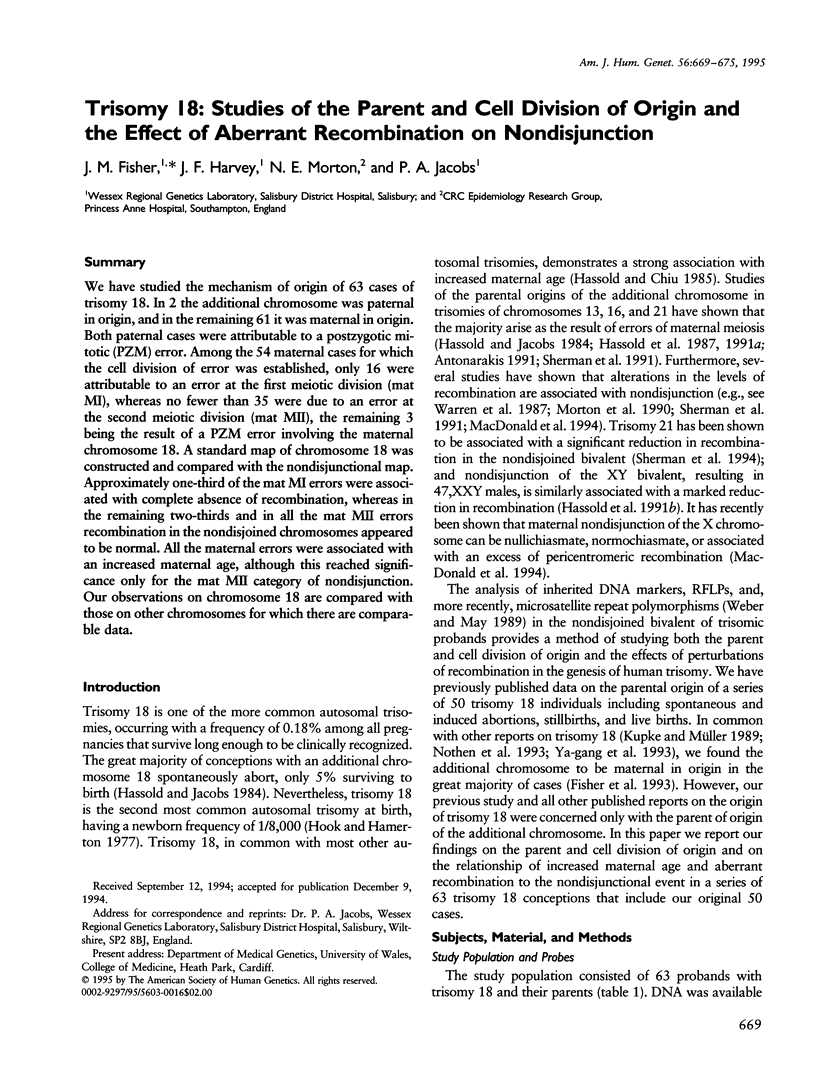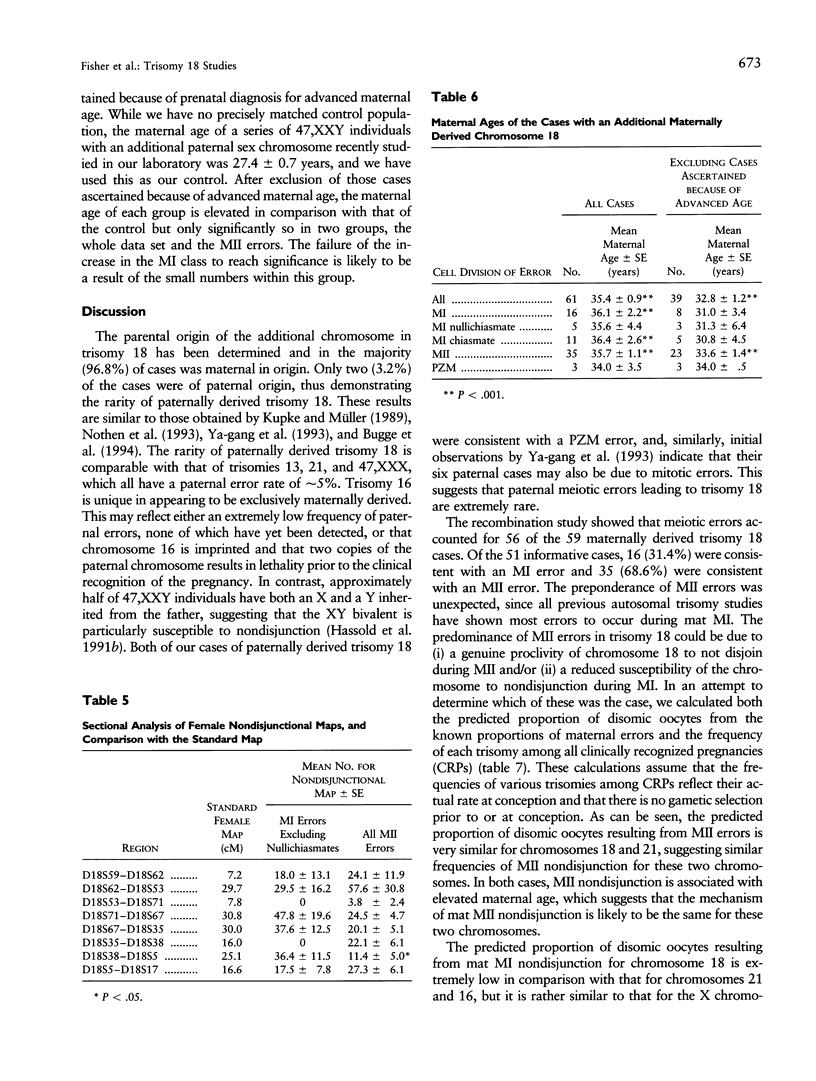Abstract
We have studied the mechanism of origin of 63 cases of trisomy 18. In 2 the additional chromosome was paternal in origin, and in the remaining 61 it was maternal in origin. Both paternal cases were attributable to a postzygotic mitotic (PZM) error. Among the 54 maternal cases for which the cell division of error was established, only 16 were attributable to an error at the first meiotic division (mat MI), whereas no fewer than 35 were due to an error at the second meiotic division (mat MII), the remaining 3 being the result of a PZM error involving the maternal chromosome 18. A standard map of chromosome 18 was constructed and compared with the nondisjunctional map. Approximately one-third of the mat MI errors were associated with complete absence of recombination, whereas in the remaining two-thirds and in all the mat MII errors recombination in the nondisjoined chromosomes appeared to be normal. All the maternal errors were associated with an increased maternal age, although this reached significance only for the mat MII category of nondisjunction. Our observations on chromosome 18 are compared with those on other chromosomes for which there are comparable data.
Full text
PDF






Selected References
These references are in PubMed. This may not be the complete list of references from this article.
- Antonarakis S. E. Parental origin of the extra chromosome in trisomy 21 as indicated by analysis of DNA polymorphisms. Down Syndrome Collaborative Group. N Engl J Med. 1991 Mar 28;324(13):872–876. doi: 10.1056/NEJM199103283241302. [DOI] [PubMed] [Google Scholar]
- Buetow K. H., Weber J. L., Ludwigsen S., Scherpbier-Heddema T., Duyk G. M., Sheffield V. C., Wang Z., Murray J. C. Integrated human genome-wide maps constructed using the CEPH reference panel. Nat Genet. 1994 Apr;6(4):391–393. doi: 10.1038/ng0494-391. [DOI] [PubMed] [Google Scholar]
- Dausset J., Cann H., Cohen D., Lathrop M., Lalouel J. M., White R. Centre d'etude du polymorphisme humain (CEPH): collaborative genetic mapping of the human genome. Genomics. 1990 Mar;6(3):575–577. doi: 10.1016/0888-7543(90)90491-c. [DOI] [PubMed] [Google Scholar]
- Fisher J. M., Harvey J. F., Lindenbaum R. H., Boyd P. A., Jacobs P. A. Molecular studies of trisomy 18. Am J Hum Genet. 1993 Jun;52(6):1139–1144. [PMC free article] [PubMed] [Google Scholar]
- Gyapay G., Morissette J., Vignal A., Dib C., Fizames C., Millasseau P., Marc S., Bernardi G., Lathrop M., Weissenbach J. The 1993-94 Généthon human genetic linkage map. Nat Genet. 1994 Jun;7(2 Spec No):246–339. doi: 10.1038/ng0694supp-246. [DOI] [PubMed] [Google Scholar]
- Hassold T. J., Jacobs P. A. Trisomy in man. Annu Rev Genet. 1984;18:69–97. doi: 10.1146/annurev.ge.18.120184.000441. [DOI] [PubMed] [Google Scholar]
- Hassold T. J., Pettay D., Freeman S. B., Grantham M., Takaesu N. Molecular studies of non-disjunction in trisomy 16. J Med Genet. 1991 Mar;28(3):159–162. doi: 10.1136/jmg.28.3.159. [DOI] [PMC free article] [PubMed] [Google Scholar]
- Hassold T. J., Sherman S. L., Pettay D., Page D. C., Jacobs P. A. XY chromosome nondisjunction in man is associated with diminished recombination in the pseudoautosomal region. Am J Hum Genet. 1991 Aug;49(2):253–260. [PMC free article] [PubMed] [Google Scholar]
- Hassold T., Chiu D. Maternal age-specific rates of numerical chromosome abnormalities with special reference to trisomy. Hum Genet. 1985;70(1):11–17. doi: 10.1007/BF00389450. [DOI] [PubMed] [Google Scholar]
- Hassold T., Jacobs P. A., Leppert M., Sheldon M. Cytogenetic and molecular studies of trisomy 13. J Med Genet. 1987 Dec;24(12):725–732. doi: 10.1136/jmg.24.12.725. [DOI] [PMC free article] [PubMed] [Google Scholar]
- Hughes A. E., Shearman A. M., Weber J. L., Barr R. J., Wallace R. G., Osterberg P. H., Nevin N. C., Mollan R. A. Genetic linkage of familial expansile osteolysis to chromosome 18q. Hum Mol Genet. 1994 Feb;3(2):359–361. doi: 10.1093/hmg/3.2.359. [DOI] [PubMed] [Google Scholar]
- Kupke K. G., Müller U. Parental origin of the extra chromosome in trisomy 18. Am J Hum Genet. 1989 Oct;45(4):599–605. [PMC free article] [PubMed] [Google Scholar]
- Le Beau M. M., Overhauser J., Straub R. E., Silverman G., Gilliam T. C., Ott J., O'Connell P., Francke U., Geurts van Kessel A. Report of the first international workshop on human chromosome 18 mapping. Cytogenet Cell Genet. 1993;63(2):78–96. [PubMed] [Google Scholar]
- MacDonald M., Hassold T., Harvey J., Wang L. H., Morton N. E., Jacobs P. The origin of 47,XXY and 47,XXX aneuploidy: heterogeneous mechanisms and role of aberrant recombination. Hum Mol Genet. 1994 Aug;3(8):1365–1371. doi: 10.1093/hmg/3.8.1365. [DOI] [PubMed] [Google Scholar]
- Matise T. C., Perlin M., Chakravarti A. Automated construction of genetic linkage maps using an expert system (MultiMap): a human genome linkage map. Nat Genet. 1994 Apr;6(4):384–390. doi: 10.1038/ng0494-384. [DOI] [PubMed] [Google Scholar]
- Morton N. E., Andrews V. MAP, an expert system for multiple pairwise linkage analysis. Ann Hum Genet. 1989 Jul;53(Pt 3):263–269. doi: 10.1111/j.1469-1809.1989.tb01793.x. [DOI] [PubMed] [Google Scholar]
- Morton N. E., Collins A. Standard maps of chromosome 10. Ann Hum Genet. 1990 Jul;54(Pt 3):235–251. doi: 10.1111/j.1469-1809.1990.tb00381.x. [DOI] [PubMed] [Google Scholar]
- Morton N. E. Gene maps and location databases. Ann Hum Genet. 1991 Jul;55(Pt 3):235–241. doi: 10.1111/j.1469-1809.1991.tb00418.x. [DOI] [PubMed] [Google Scholar]
- Morton N. E., Keats B. J., Jacobs P. A., Hassold T., Pettay D., Harvey J., Andrews V. A centromere map of the X chromosome from trisomies of maternal origin. Ann Hum Genet. 1990 Jan;54(Pt 1):39–47. doi: 10.1111/j.1469-1809.1990.tb00359.x. [DOI] [PubMed] [Google Scholar]
- Morton N. E., Wu D., Jacobs P. A. Origin of sex chromosome aneuploidy. Ann Hum Genet. 1988 May;52(Pt 2):85–92. doi: 10.1111/j.1469-1809.1988.tb01083.x. [DOI] [PubMed] [Google Scholar]
- Nöthen M. M., Eggermann T., Erdmann J., Eiben B., Hofmann D., Propping P., Schwanitz G. Retrospective study of the parental origin of the extra chromosome in trisomy 18 (Edwards syndrome). Hum Genet. 1993 Oct;92(4):347–349. doi: 10.1007/BF01247332. [DOI] [PubMed] [Google Scholar]
- Petersen M. B., Economou E. P., Slaugenhaupt S. A., Chakravarti A., Antonarakis S. E. Linkage analysis of the human HMG14 gene on chromosome 21 using a GT dinucleotide repeat as polymorphic marker. Genomics. 1990 May;7(1):136–138. doi: 10.1016/0888-7543(90)90531-x. [DOI] [PubMed] [Google Scholar]
- Saiki R. K., Gelfand D. H., Stoffel S., Scharf S. J., Higuchi R., Horn G. T., Mullis K. B., Erlich H. A. Primer-directed enzymatic amplification of DNA with a thermostable DNA polymerase. Science. 1988 Jan 29;239(4839):487–491. doi: 10.1126/science.2448875. [DOI] [PubMed] [Google Scholar]
- Shahar S., Morton N. E. Origin of teratomas and twins. Hum Genet. 1986 Nov;74(3):215–218. doi: 10.1007/BF00282536. [DOI] [PubMed] [Google Scholar]
- Sherman S. L., Petersen M. B., Freeman S. B., Hersey J., Pettay D., Taft L., Frantzen M., Mikkelsen M., Hassold T. J. Non-disjunction of chromosome 21 in maternal meiosis I: evidence for a maternal age-dependent mechanism involving reduced recombination. Hum Mol Genet. 1994 Sep;3(9):1529–1535. doi: 10.1093/hmg/3.9.1529. [DOI] [PubMed] [Google Scholar]
- Sherman S. L., Takaesu N., Freeman S. B., Grantham M., Phillips C., Blackston R. D., Jacobs P. A., Cockwell A. E., Freeman V., Uchida I. Trisomy 21: association between reduced recombination and nondisjunction. Am J Hum Genet. 1991 Sep;49(3):608–620. [PMC free article] [PubMed] [Google Scholar]
- Straub R. E., Speer M. C., Luo Y., Rojas K., Overhauser J., Ott J., Gilliam T. C. A microsatellite genetic linkage map of human chromosome 18. Genomics. 1993 Jan;15(1):48–56. doi: 10.1006/geno.1993.1008. [DOI] [PubMed] [Google Scholar]
- Warren A. C., Chakravarti A., Wong C., Slaugenhaupt S. A., Halloran S. L., Watkins P. C., Metaxotou C., Antonarakis S. E. Evidence for reduced recombination on the nondisjoined chromosomes 21 in Down syndrome. Science. 1987 Aug 7;237(4815):652–654. doi: 10.1126/science.2955519. [DOI] [PubMed] [Google Scholar]
- Weber J. L., May P. E. Abundant class of human DNA polymorphisms which can be typed using the polymerase chain reaction. Am J Hum Genet. 1989 Mar;44(3):388–396. [PMC free article] [PubMed] [Google Scholar]
- Weissenbach J., Gyapay G., Dib C., Vignal A., Morissette J., Millasseau P., Vaysseix G., Lathrop M. A second-generation linkage map of the human genome. Nature. 1992 Oct 29;359(6398):794–801. doi: 10.1038/359794a0. [DOI] [PubMed] [Google Scholar]
- Ya-gang X., Robinson W. P., Spiegel R., Binkert F., Ruefenacht U., Schinzel A. A. Parental origin of the supernumerary chromosome in trisomy 18. Clin Genet. 1993 Aug;44(2):57–61. doi: 10.1111/j.1399-0004.1993.tb03847.x. [DOI] [PubMed] [Google Scholar]
- van Kessel A. G., Straub R. E., Silverman G. A., Gerken S., Overhauser J. Report and abstracts of the second international workshop on human chromosome 18 mapping. Doorwerth, the Netherlands, July 19-20, 1993. Cytogenet Cell Genet. 1994;65(3):142–165. [PubMed] [Google Scholar]


